Luận án Better utilisation of manure in integrated pig-fish farming in Viengchang, Lao PDR
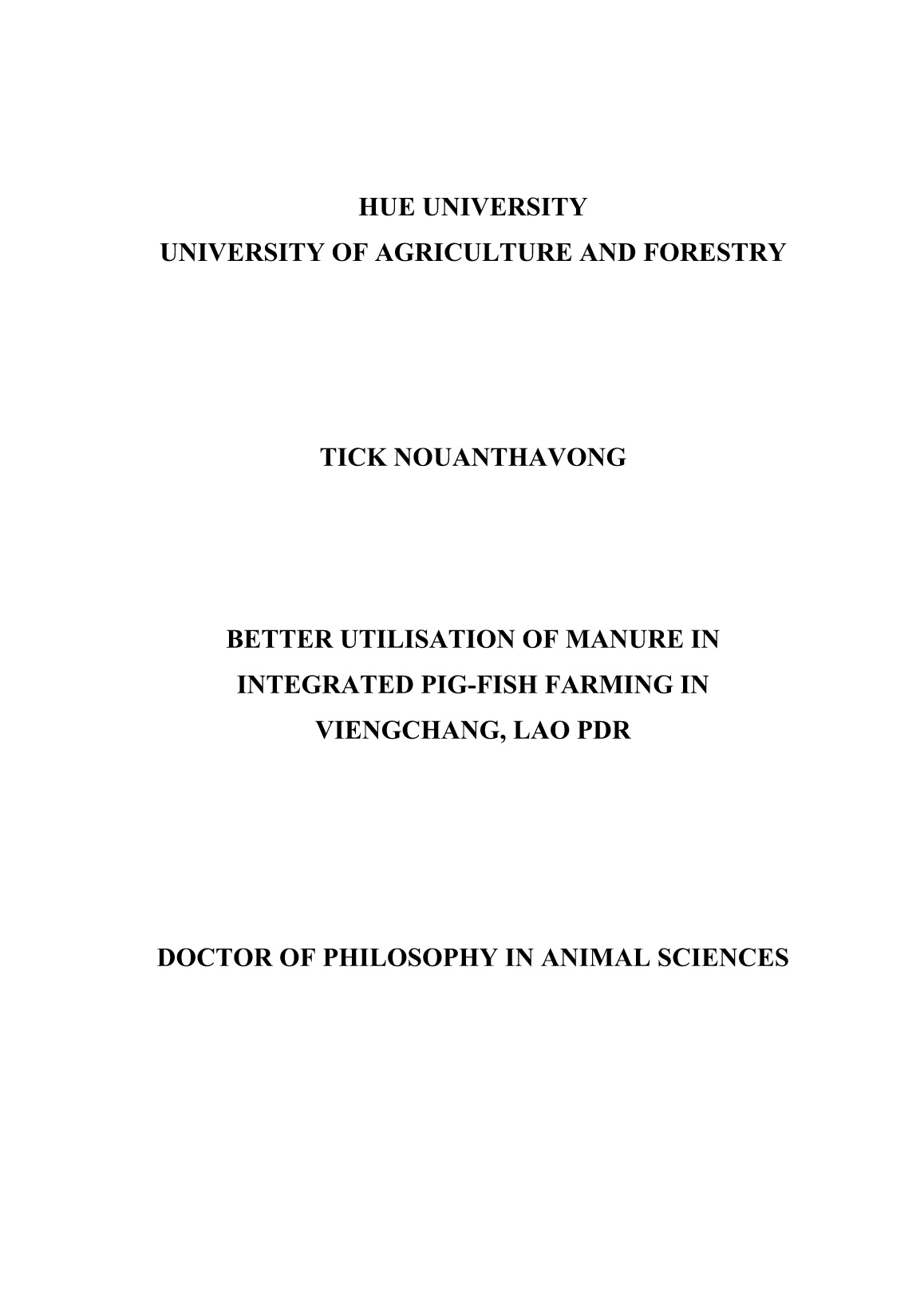
Trang 1
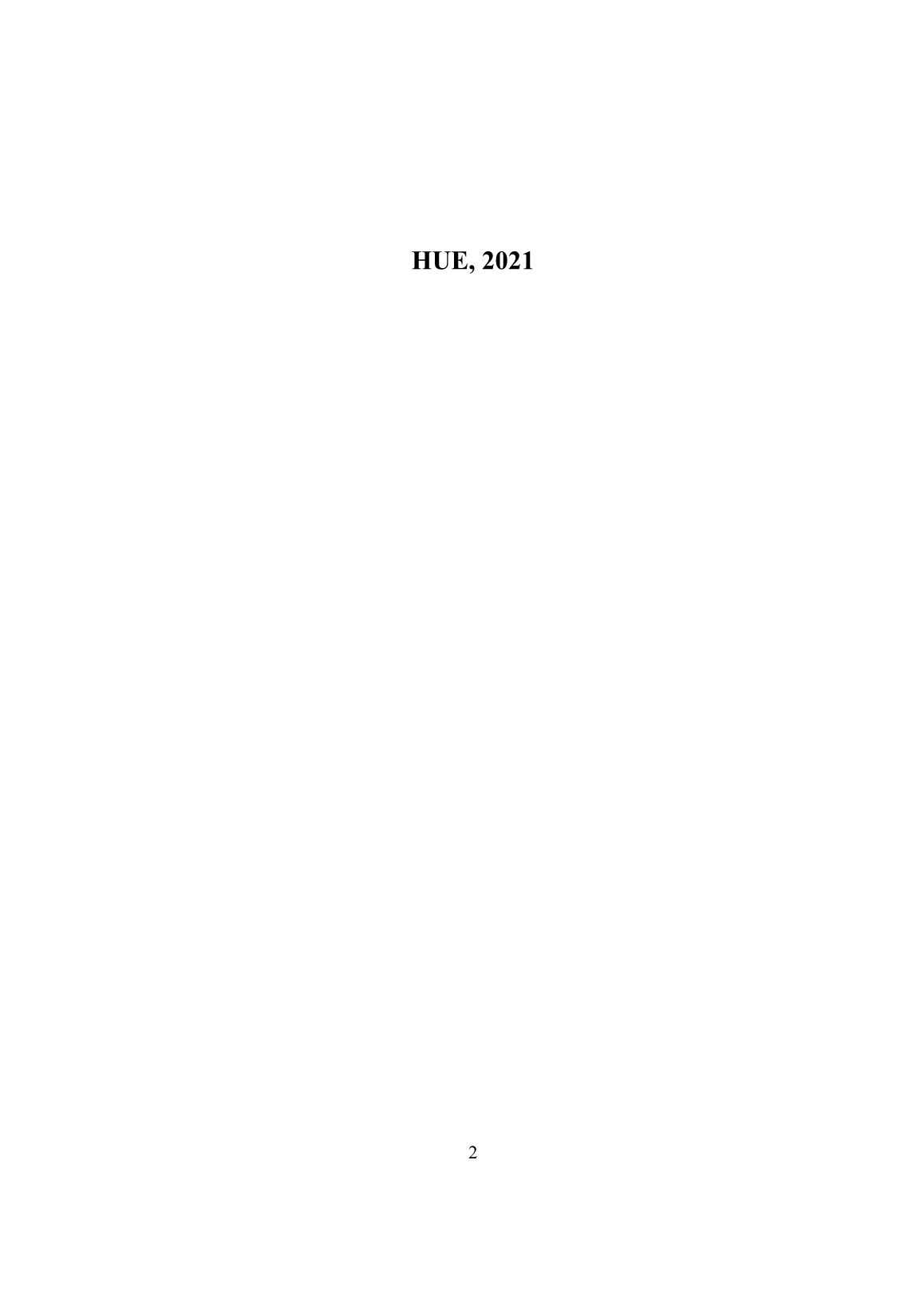
Trang 2
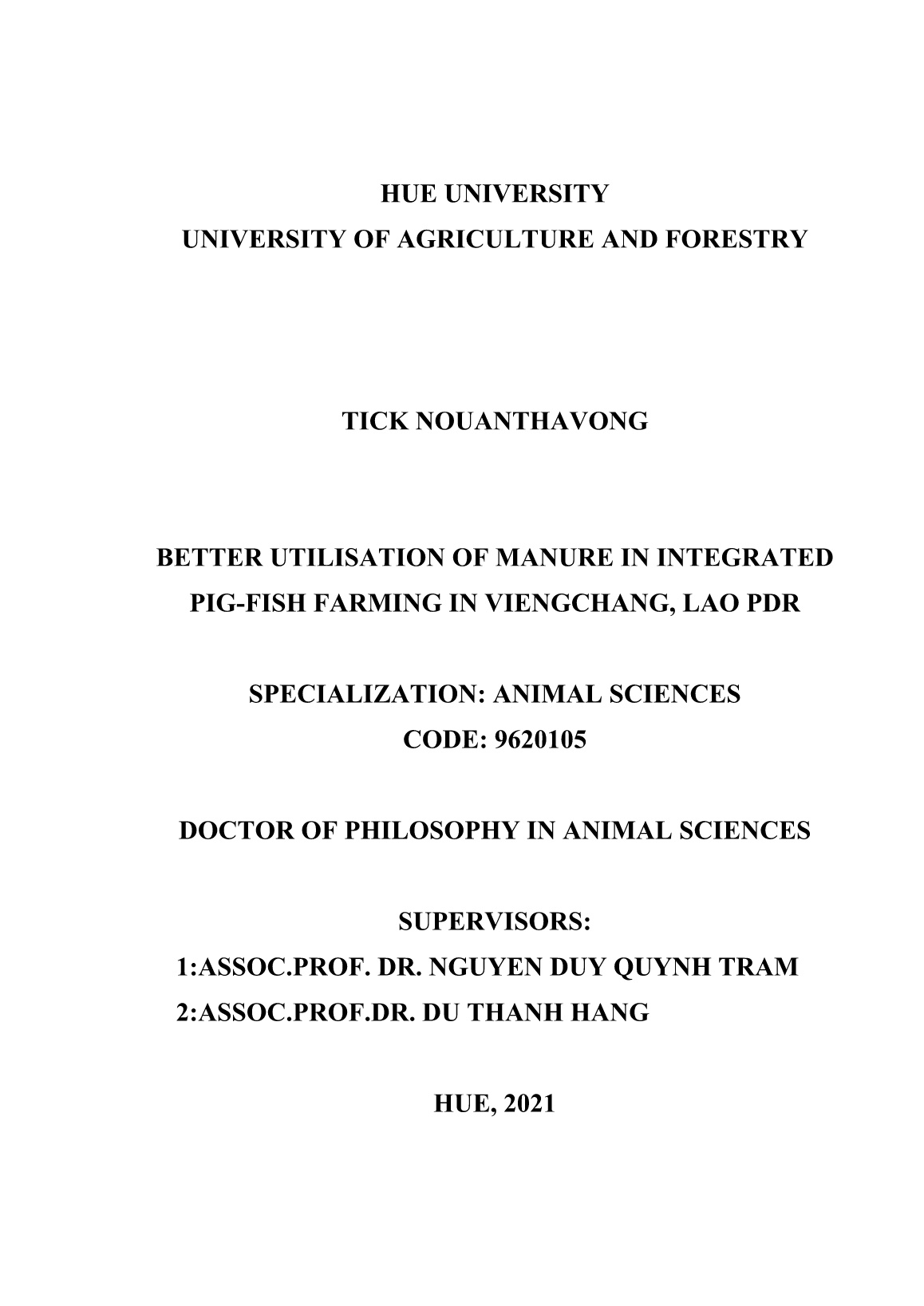
Trang 3
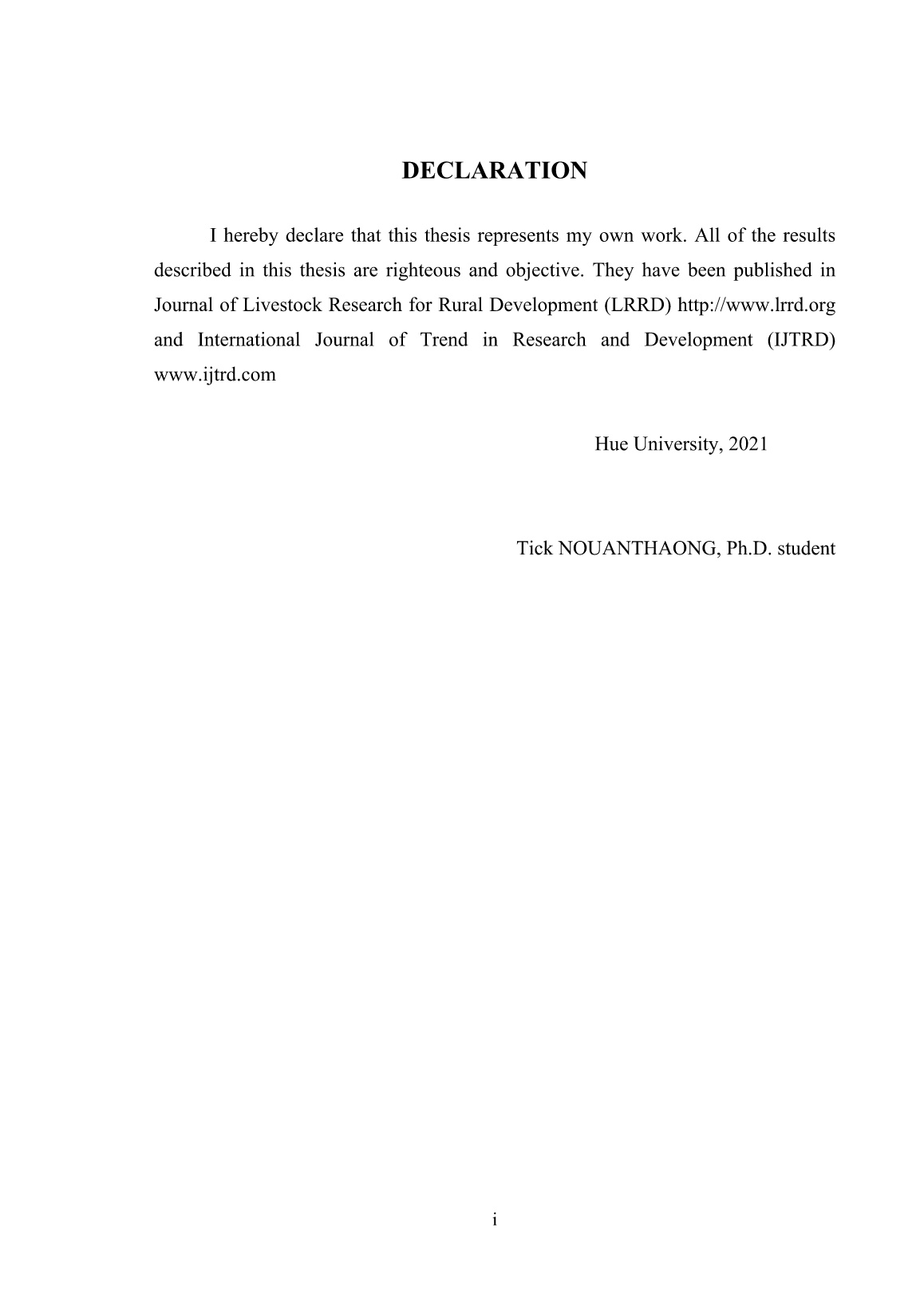
Trang 4
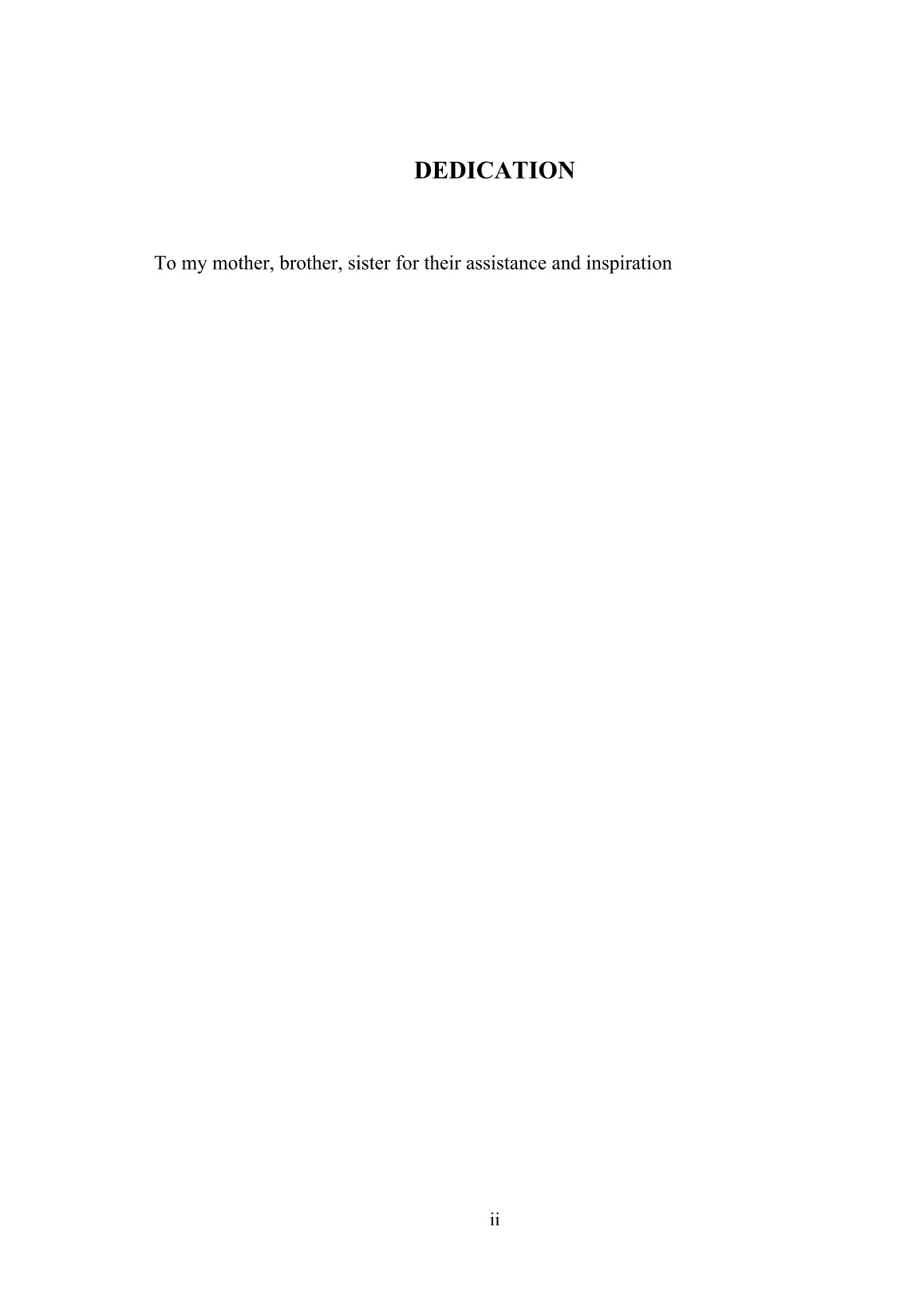
Trang 5
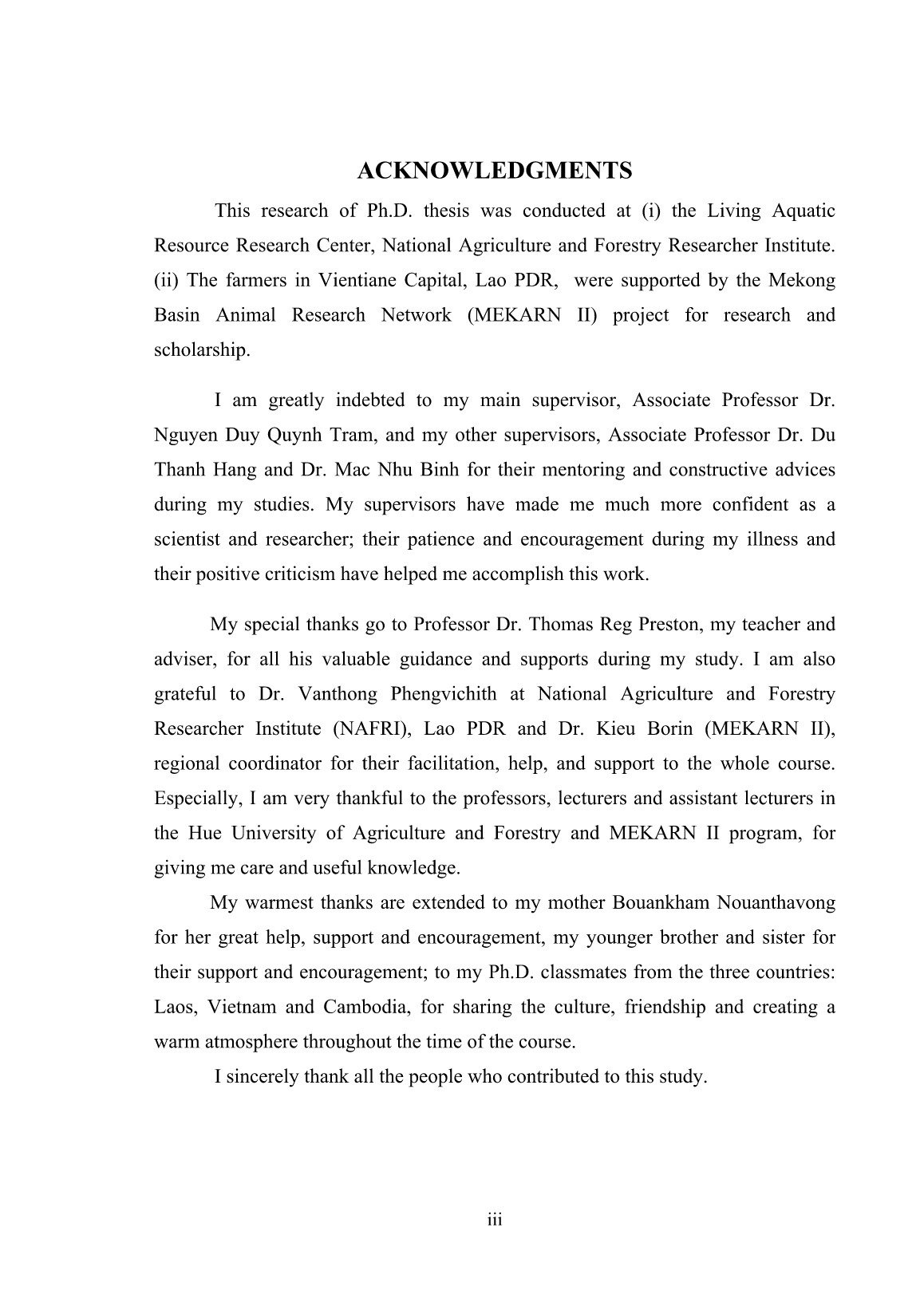
Trang 6
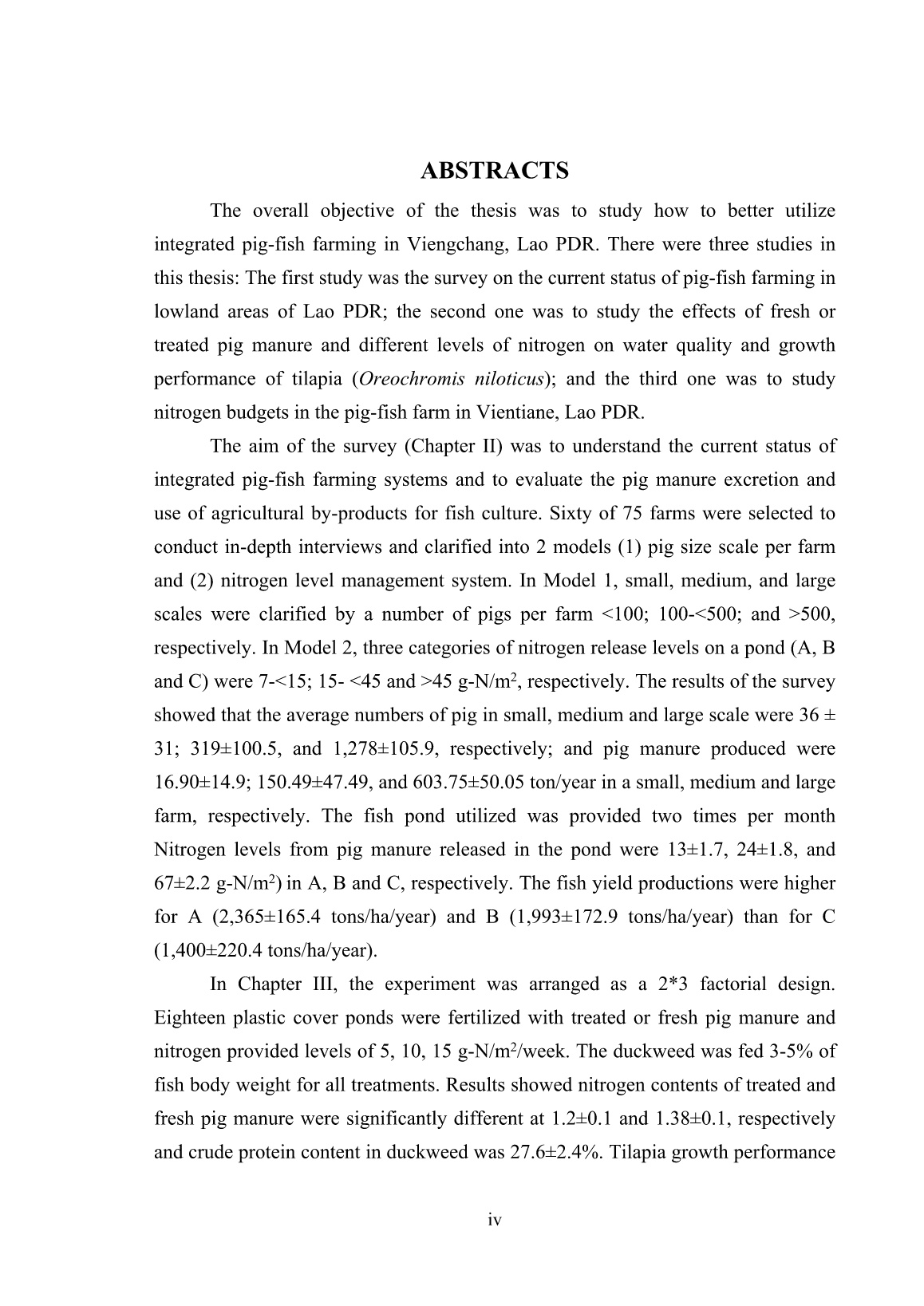
Trang 7
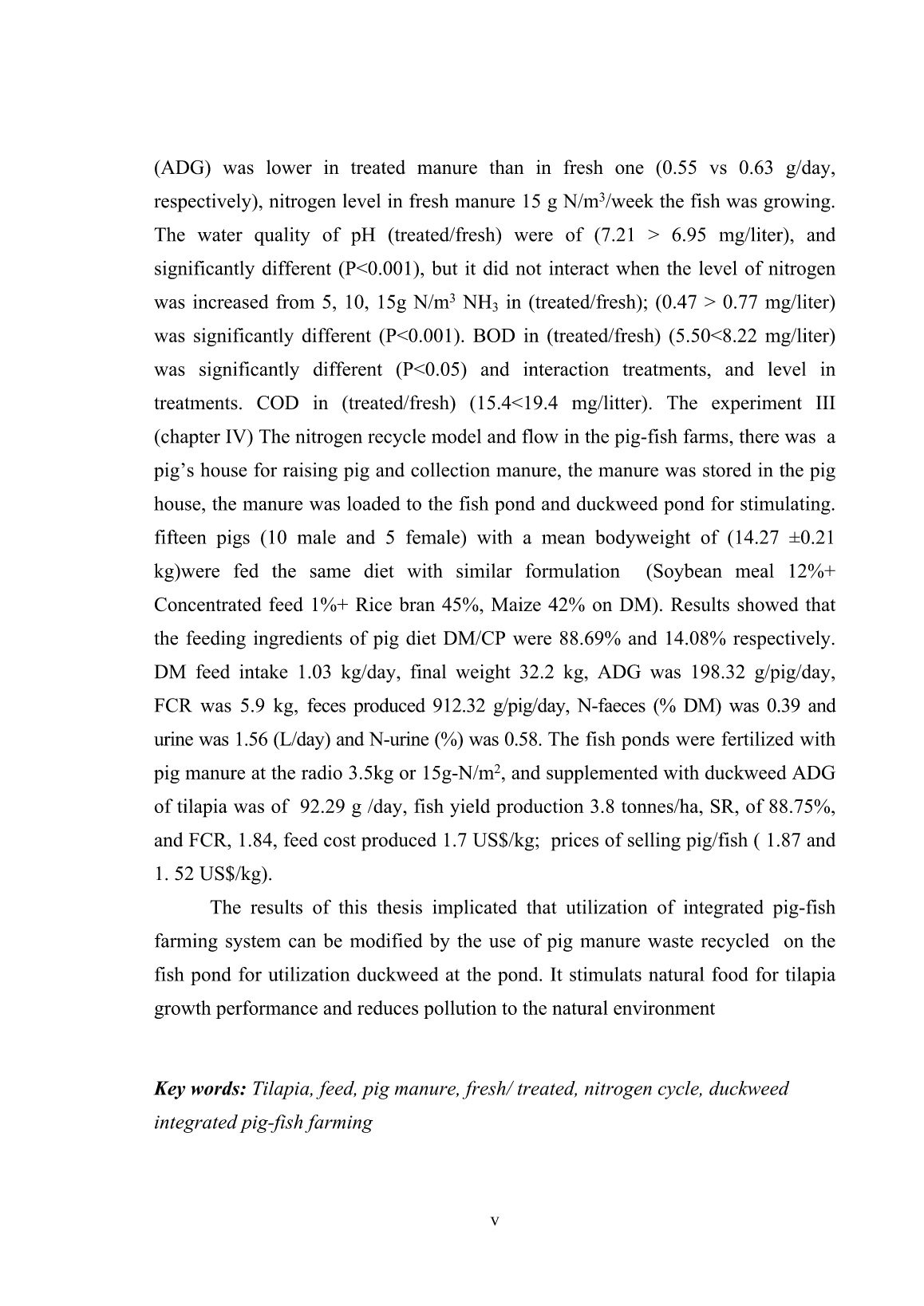
Trang 8
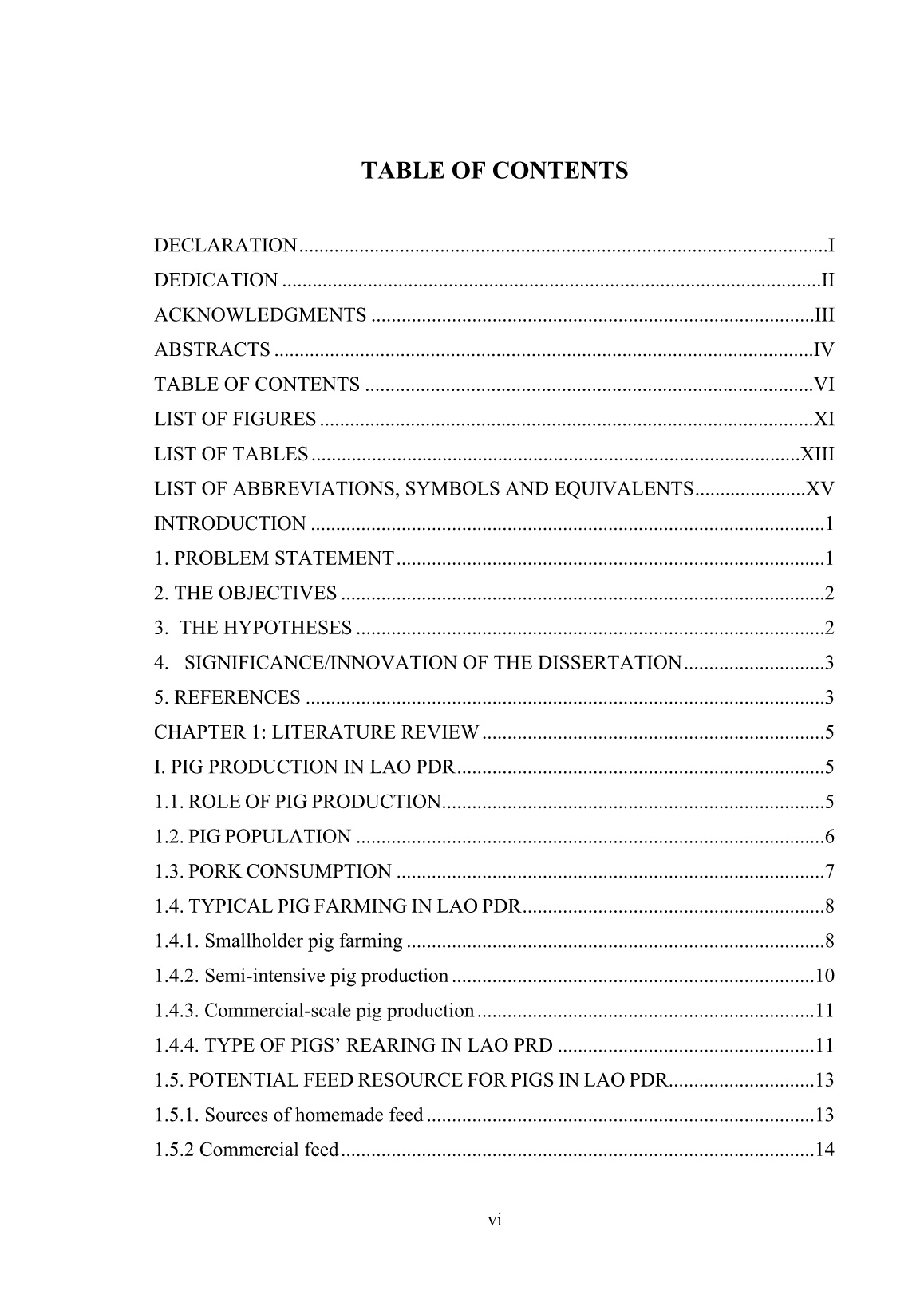
Trang 9
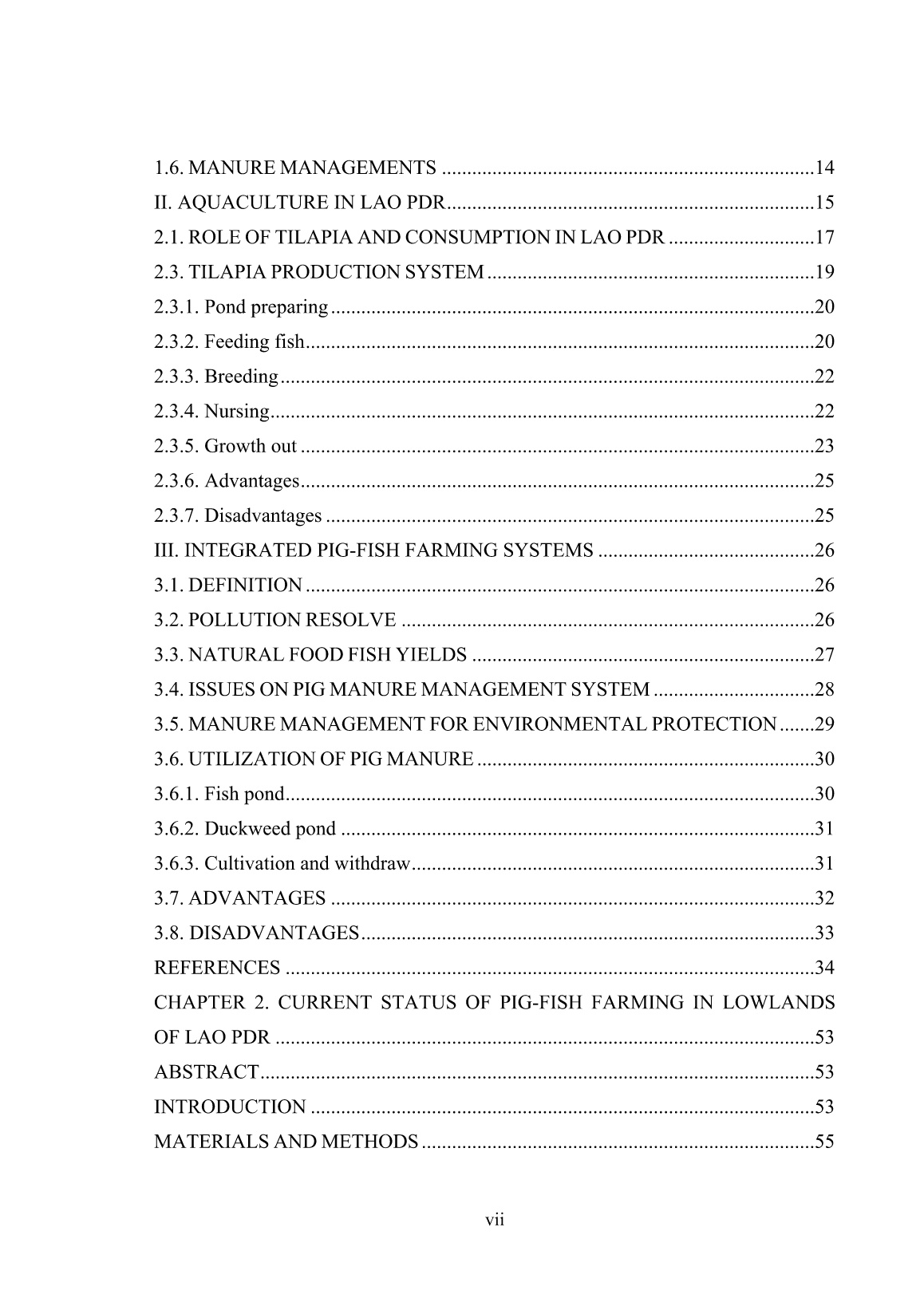
Trang 10
Tải về để xem bản đầy đủ
Bạn đang xem 10 trang mẫu của tài liệu "Luận án Better utilisation of manure in integrated pig-fish farming in Viengchang, Lao PDR", để tải tài liệu gốc về máy hãy click vào nút Download ở trên.
Tóm tắt nội dung tài liệu: Luận án Better utilisation of manure in integrated pig-fish farming in Viengchang, Lao PDR
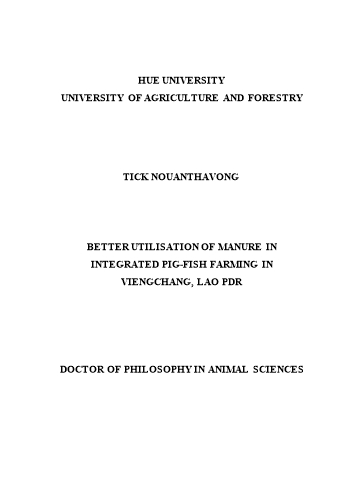
Blacksell, S.D et al., 2017. Integrating market chain assessments with zoonoses risk analysis in two cross-border pig value chains in Lao PDR. Asian-Australas. J. Anim. Sci., 30 (11) (2017), p. 1651. Oosterwijk, G., Van Aken, D., and Vongthilath, S et al., 2003. A manual on improved rural pig production (1st edition, Einglish Language). Ministry of Agriculture and Forestry: Vientiane: Lao People's Democratic Republic. Oribhabor, B.J., ANSA, E.J., 2006. Organic waste reclamation, recycling and re-use in integrated fish farming in the Niger Delta. Journal of Applied Sciences & Environmental Management, Vol. 10, No. 3, September, 2006, pp. 47-53. Osada, T., Rom, H.B., and Dahl, P., 1998. Continuous measurement of nitrous oxide and methane emission in pig units by infrared photoacoustic detection. Trans. ASAE 1998, 41, 1109-1114. Pereira, L. P. F., and Mercante, C. T. J., 2005. A amụnia nos sistemas de criaỗóo de peixes e seus efeitos sobre a qualidade da ỏgua-uma revisóo. Boletim do Instituto de Pesca, 31: 81-88. Phanthavongs S and Saikia U., 2013. Biogas digesters in small pig farming systems in Lao PDR: evidence of an impact. Livestock Research for Rural Development. Volume 25, Article #216. Phengsavanh, P. and Stỹr, W., 2006. The use and potential of supplementing village pigs with Stylosanthesguianensis in Lao PDR. Workshop-seminar "Forages for Pigs and Rabbits" MEKARN-CelAgrid, Phnom Penh, Cambodia, 22-24 August, 2006. Article # 14. Retrieved November 8, 115. Phengsavanh, P., Ogle, B., Frankow-Lindberg, B.E. and Lindberg, J.E et al., 2011. Smallholder pig rearing systems in Northern Laos. Asian-Australalian Journal of Animal Sciences 24(6), 867-874. Phengsavanh, P., Ogle, B., Stỹr, W., Frankow-Lindberg, B.E. and Lindberg, J.E., et al 2010. Feeding and performance of pigs in smallholder production systems in Northern Lao PDR.Tropical Animal Health and Production 42:1627-1633, 1-7. Phengvilaysouk, A., Jansson, A., Phengsavanh, P., Tiemann, T., Phengvichith, V. and Lindberg, J.E et al., 2017. Sow and piglet management in small-holder and larger-scale pig farms in Northern part of Laos. Livestock Research for Rural Development. 29 (201). Philavong, S., Khang, D.K., and Preston, T.R., 2017. Duckweed (Lemna spp) amended with biochar as feed for Tilapia (Oreochromis niloticus). Living Aquatic Resource Research Centre (LARReC). Phonvisay, A., and Bush, S. R et al., 2001. Baseline Study of Fish Trade from the Siiphandone Fishery, LARReC Technical Report No. 0004, LARReC, Vientiane. Phonvisay ,S., 2003 .Country report for Animal Genetic Resources Management in the Lao Department of Livestock and Fisheries, Ministry of Agriculture and Forestry, PDR p 7,from: ftp://ftp.fao.org/docrep/fao/010/a1250e/annexes/-CountryReports/LaoPDR.pdf. Prabu, E., Rajagopalsamy, C. B. T., Ahilan, B., Jegan Michael Andro Jeevagan, I.,and Renuhadevi, M et al., 2019. Tilapia An Excellent Candidate Species for World Aquaculture. Published 29 March 2019. DOI: 10.9734/ARRB/2019/-v31i330052. Prabu, E., Santhiya, A.A.V., 2016. An overview of bioremediation towards aquaculture. Journal of Aquaculture in the Tropics. 2016; 31(3-4):155. Primer, A et al., 2001. Integrated agriculture-aquaculture. FAO/IIRR/World Fish Center 2001. ISBN 92-5-104599-2. REFARM. (Resilience Framework for Agriculture and Risk Management Database) et al., 2018. Fish Culture in Integrated Farming Systems. Rege, J.E.O., and Gibson. J.P., 2003. “Animal Genetic Resources and Economic Development: Issues in Relation to Economic Valuation”. Ecological Economics, 45: 319-330. Remedios L, Lopez P., 2000. Aquaculture notes in china. Presented to the registration of cop yright. Havana Cuba. Riche, M., and Garling, D. et al., 2003. Feeding Tilapia in Intensive Recirculating Systems.This report is available at Iowa State University Digital Repository: Sahoo, U. K., Singh S. L., 2015. Integrated Fish-Pig and Fish-Poultry Farming in East Kalcho, Saiha District of Mizoram, North-East India: An Economic Analysis. International Journal of Agriculture and Forestry 2015, 5(5): 281-286 DOI: 10.5923/j.ijaf.20150505.03 Sapkota, A., Sapkota, A.R., Kucharski, M., Burke, J., McKenzie, S., Walker, P., et al., 2008. Aquaculture practices and potential human health risks: current knowledge and future priorities. Environ. Int. 34, 1215-1226. Scorvo Filho, J.D., Frascỏ-Scorvo C.M.D., Alves J.M.C.G.N.A., Souza F.R.A.D., 2010. A tilapicultura e seus insumos, relaỗừes econụmicas. Revista Brasileira de Zootecnia; 2010. Selim, K.M. and Reda, R.M. , 2015. Improvement of immunity and disease resistance in the Nile tilapia, Oreochromis niloticus, by dietary supplementation with Bacillus amyloliquefaciens. Fish and Shellfish Immunol., (44): 496-503. Sevillejas, R. Torres, J. Sollows J. and Little, D et al., 2001. Using animal wastes in fishponds. Fish Feeding and Management. Integrated agriculture-aquaculture. FAO/IIRR/World Fish Center 2001. ISBN 92-5-104599-2. Shenglin, Y., 2007. Genetic diversity of Thai indigenous pigs, wild boars and Chinese Qianbei black pigs based on microsatellite and sequence polymorphism of mitochondria and 61. Cytochrome b gene. A thesis sunmitted in partial fulfillment of the requirement for the degree of doctor of philosophy in animal production technology, Suranaree University of Technology, Thailand. Shober, A.L., Moore, K.A., Hasing, G., Wiese, C., Denny, G.C. & Knox, G.Wet al., 2014 Effect of nitrogen fertilization rate on aesthetic quality of landscape-grown vines and groundcovers HortTechnology 24 604 609. Sims, J.T. Maguire, R.O et al., 2005. Encyclopedia of Soils in the Environment. Sipaỳba-Tavares et al ., 2006. That is the absence of dispose of pig manure this fish pond causes higher pH and dissolved oxygen levels in the water, since the amount of organic matter to endure dissolution is lower when compared to other fish ponds. Smith, K.A., Brewer, A.J., Dauven, A., Wilson, D.W., 2000. A survey of the production and use of animal manures in England and Wales. I. Pig manure. Soil Use Manage. 16, 124-132. Sońta, M., Rekiel,A., Batorska, M et al.,2019. Use of duckweed (Lemna L.) in sustainable livestock production and aquaculture. Ann. Anim. Sci., Vol. 19, No. 2 (2019) 257-271 DOI: 10.2478/aoas-2018-0048. Stỹr, W. Gray, D. and Bastin, G et al., 2002a. Review of the Livestock Sector in the Lao People’s Democratic Republic. Prepared by ILRI for the Asian Development Bank, Manila, Philippines, 50pp. Stỹr, W., Phengsavanh, P., Keonouchanh, S. and Kopinski, J et al., 2008. Forage legumes for supplementing village pigs in Lao PDR, Project Annual Report 2008, ACIAR, Canberra, Australia. Syphachanh, T. L. and Vannasy et al., 2017. Diversifying rice production with frogs, fish and more; LAOS- A Story of change on rice production Taylor, E.V., Herman, K.M., Ailes, E.C., Fitzgerald, C., Yoder, J.S., Mahon, B.E., et al., 2013. Common source outbreaks of Campylobacter infection in the USA, 1997-2008. Epidemiol. Infect. 141, 987-996. Teenstra, E., De Buisonjộ, F., Ndambi,A., and Pelster, D., 2015. Manure Management in the (Sub-)Tropics; Training Manual for Extension Workers. Wageningen, Wageningen UR (University & Research centre) Livestock Research, Livestock Research Report 919. Tiemann, T.T., Phengvilaysouk, A., and Keonouchanh, S et al., 2017. Herd dynamics reflect constraints for pig production and farmer attitudes in smallholder systems in Lao PDR. Animal Production Science. ss. A-I. Towers, T. 2015 . Hatchery management and tilapia fingerling production. Tripathi, S.D., and Sharma, B.K., 2001. Integrated fish-pig farming in India Integrated agriculture-aquaculture. FAO/IIRR/World Fish Center 2001; ISBN 92-5-104599-2. Verdegem,M.C.J., Bosma, R.H., 2009.Water withdrawal for brackish and inland aquaculture, and options to produce more fish in ponds with present water use. Water Policy 11 Supplement 1 (2009) 52-68. doi: 10.2166/wp.2009.003. IWA Publishing 2009. Vikaspedia et al., 2019. Training manual on "Polyculture and integrated fish farming" publihed by College of Fisheries, Assam Agricultural University, Raha - 782103, Nagaon, Assam. Vonglokham, K.K et al., 2017. Fisheries Country Profile Lao PDR. Southeast Asian Fisheries Development Center. Regional Fisheries Policy Network (RFPN) Member for Lao PDR. Vongthilath, S. and Blacksell, S., 1999. Classical swine fever in Lao PDR. In: ACIAR Proceedings No 94. Australian Centre of International Agriculture Research: Canberra, Australia, Pp, 122-125. Vu, T.K.V., Tran, M.T., Dang, T.T.S et al., 2007. A survey of manure management on pig farms in Northern Vietnam. Livest. Sci. 112, 288e297. Wilson, R.T., 2007. Status and prospects for livestock production in the Lao People's Democratic Republic. Tropical Animal Health and Production 39, 443-452. Wohlfarth, G., and Schroeder, G.L., 1979. Use of manure in fish farming - A review. Agricultural Wastes 1(4), 279-299. World., 2017. Laos Population Review. WortFish., 2009. Producing tilapia feed locally: A low cost option for small-scale farmers. Xayalath, S. And Sacklokham, S., 2010. Study the impact of villages’ Pig Bank implementing in Khua and Samphanh districts, Phongsaly province, Laos. Department of rural economic and food technologies; Faculty of Agriculture; National university of Laos Xayalath, S., Sacklokham, S., Kaensombath, L et al., 2016. Study on indigenous pig production system and its market potential for improving livelihood of farmers in Lao Ngam district Saravanh province. Division of post graduated; Faculty of Agriculture; National university of Lao PDR. Xiong, W.G., Sun, Y.X., Zhang, T., Ding, X.Y., Li, Y.F., Wang, M.Z., Zeng, Z.L et al., 2015. Antibiotics, antibiotic resistance genes, and bacterial community composition in fresh water aquaculture environment in China. Microb. Ecol. 70, 425-432. Xu, Z and Boyd, C. E., 2016. Reducing the monitoring parameters of fish pond water quality. Aquaculture, 465(1): 359-366. Xue, C., Yang, C.J., Liang, J.R., Dong, X.M., Tu, E.S.J., Mo, H.T., et al., 2007. Detection of AntiHEV in Sera of 7 Animal Species. Yang, H., 2006b. Reproduction and culture techniques of tilapia. Scientific Fish Farming, 2: 16-17. (In Chinese). Zawadzki, K. ., 2016. Possibilities for the use of natural high-protein raw materials (duckweed and flies) for feed purposes (in Polish). Przegl. Zboż. Młyn., 1: 53. Zhang, D. Wang,X. and Zhou,Z., 2017. Impacts of Small-Scale Industrialized Swine Farming on Local Soil, Water and Crop Qualities in a Hilly Red Soil Region of Subtropical China. Int J Environ Res Public Health. 2017 Dec; 14(12): 1524. Zhou, Z.G., Li Z.P., He Y.Q., Wang X.X., 2013. Scale pig farming and its impacts on soil and water environment in red soil hilly regions: A case study of Yujiang County, Jiangxi Province, China. Acta Pedol. Sin. 2013; 50:703-7 CHAPTER 2 CURRENT STATUS OF PIG-FISH FARMING IN LOWLANDS OF LAO PDR ABSTRACT The survey was focused on the most integrated pig-fish farming areas in two districts (Nasaythong and Saythani), in which 60 of 75 farms were selected to in-depth interview. The data were collected from the secondary information and primary data collect during the individual farmer interview using the questionnaire. And then the data were analysed by two models based on pig number per farm (3 types of farm size: small, medium and large) and pig manure nitrogen (3 categories: A - low, B - medium and C - high) directly released on the pond. In the first model, the results showed that the average pig number in small (500 pigs) are 36±95.8; 319±100.5; and 1,278±105.9; respectively. Manure productions per farm in small, medium and large scale are 16.90±45.28; 150.49±47.49 and 603.75±50.05 tonnes/year, respectively. The manure was released directly in the fish pond or stored before being utilized. In the second model, it was found that manure was applied two times per month. The levels of manure nitrogen in 3 categories are 13±1.7; 24±1.8 and 67±2.2 g-N/m2, respectively. The fish cultured in the pond included four geneses (Tilapia ssp; Silver barp; Chinese carp; and Indian carp) with 8 ±1.02 months. The fish yield in 3 categories are higher in A (2,365±165.4) than in B (1,993±172.9) and C (1,400±220.4). Estimated income for small, medium and large scale 19,0; 56,0 and 33% of the investment, respectively. Keywords: manure nitrogen, pig-fish farming, survey, Tilapia INTRODUCTION The integrated system has better energy efficiency, is more sustainable and is less stressful on the environment in comparison with separated production subsystems (Ortega, 2004). The technique (integrated pig-fish farming) should be promoted to improve the present level of farm production in rural areas and in developing countries where fish remains as a major commodity for local consumption (Haobijam, 2018). Commercial livestock raising is increasingly becoming a cost-intensive and low-profit-oriented farming practice, primarily due to an increase in the involvement of high cost of animal feed. In the integrated system, this can be compensated by raising a fish crop utilizing the animal waste and thereby generating additional revenue (Bhattacharjya, 2017). The integrated pig-fish farming system from wastes of the pig manure was used as fertilizer in the natural pond for fish growth. This greatly reduced the cost of fish production in the pond, therefore increasing the profitability of the integrated pig-fish farming system (Keshab Barman, 2016). Integrated pig-fish farming is considered better as compared to other livestock integrated systems. Pig manure can either be used directly or partially decomposed before application in the fish pond as pig manure restrain about 70% digestible matter for fish besides, left-over pig fed serves as direct food. Pig manure was enhanced fertilized for planktons and as fish fed (Kujur et al., 2005; Kumar and Mishra, 2015). The integrating fish with livestock is the availability of a large number of nutrients (N-P-K), with possible proportions of 72-79% nitrogen, 61-87% phosphorus, and 82-92% potassium, as a fertilizer in the fish pond to produce plankton of high-protein natural food of fish. There was demonstrated that fish production can be applied when the manures are properly applied to fish on culture systems (Shoko, 2011). Integrated fish farming seems to be favour antimicrobial-resistant bacteria in the pond environment. This could attribute to the selective pressure of antimicrobials in the pond environment and/or to the introduction of antimicrobial-resistant bacteria from animal manure and potential risks to human health (Petersen, 2002). However, the bacterial and eukaryotic microbial compositions of fish ponds are influenced by specific livestock manure more sensitively and responsively. Animal manure used as fertilizer induces a primarily prebiotic effect on the pond ecosystem rather than a direct probiotic effect on fish (Minich, 2018). Objectives To understand the existing integrated pig-fish farming systems in lowlands; To evaluate the pig manure excretion and agriculture by-products for fish culture. MATERIALS AND METHODS Study area and farm selection The survey on the integrated pig-fish farming system was carried out in Vientiane Capital (Figure 1). Study areas were Nasaythong and Saythani districts, which are about 30 km far from the center. A total number of 60 farms out of 70 farms were selected to conduct the in-depth interviews. Figure 1. Study site Precedes farms . The 09 districts in the selected Vientiane Capital were selected based on the relative importance of integrated pig-fish in their agricultural sectors, according to secondary data from DLF/PAFO/DAFO. This criterion was defined in integrated pig-fish (pig house and fish pond area/total agricultural land area) and pig production, fish culture, density The 02 districts selected from 09 districts kept using a production scale, in the integrated pig-fish farming system. The decision was based on consultation with local experts with regards to the prevalence of farmers and environmental challenges of raising from in integrated pig-fish. The interview was implemented individually using the questionnaire designed the issues of pig production, fish culture, productivity, waste management, problems and benefits of raising pigs and fish. This information was then reviewed from the District of Agriculture and Forestry, considering the number of farms and their vicinity. Data collection Feeding systems of the efficiency feed (Homemade/commercial) Farm models managements system (farms scale, number of pigs, level of nitrogen produced and applies to fish ponds, pond areas, fish yield) Manure management: how does pig manure use in farm and estimation of total nitrogen in manure on each farm-scale (directly/stored in the pond) Data management and statistical analyses All of the data was managed and analysed in the worksheet of Microsoft Excel (2010). Two models Model 1: farm scales Model 2: nitrogen levels applied in the pond g N/m2 pond Small with 500 pigs C: >45 The data on pig number, manure produced, pond areas, fish yield and the quality of nitrogen loading into the fish pond were analysed by the general linear model in the ANOVA program of the Minitab software version 16 (2010). The differences between means were analyzed by Tukey method with the confident interval 95%. analysis The data were entered into a spreadsheet and analyzed using PASW Statistics 18 (2009) for descriptive analysis of means, medians and ranges, frequency of distribution, and variation. The growth rate and reproductive perfor- mance were analyzed statistically by variance analysis (ANOVA) using the general linear model procedure of Minitab Statistical Software (Minitab 2007). When the differences between means were significant at the proba- bility level of p<0.05, the means were compared using Tukey’s pair-wise comparison test. RESULTS Pig-fish production systems Analysis as farm scale In 60 surveyed farms, pig-fish farming systems were found. However, there are different scales in term of farm scale (number of pig per farm, pond area). Number of pigs per farm ranged 10 to 1,500 animals, and pond area of 150-2,300 m2. In each farm, piggery and pond are close and some farms have fruit garden with small size. Data in Table 1 show that pigs in small scale were mainly fed by local feedstuff (photo 1), and in medium and large scale used commercial feed (33.33%; 30%, respectively). Photo 1: Homemade (Local feed) Data in Table 1 also indicate that manure managements in different farm scales are significant. In small scale, farmers applied fresh manure directly to fish pond and cultivation (crop and fruit tree). It was estimated 37% of surveyed farms. In the medium scale, farmers stored manure for some time before applying to fish pond (33% of surveyed farms), and the same way for large scale (7%). In the large scale, farmers stored manure and applied in the pond, crops and fruit tree (23% of surveyed farms). Photo 2: Manure utilized fish pond directly Photo 3. Crops and fruit cultivation in pig-fish farms (banana, mango, coconut, and lemon Table 1. Pig feeding model and manure management in integrated pig-fish farm of (%) Details Farm model 1 Small Medium Large Number of farms 22 20 18 Feeding: Commercial feed - 33.33 30.00 Local feed (homemade) 36.67 - - Manure management: Fish pond+ crop and fruit tree 37.00 - - Stored + fish pond - 33.00 7.00 Stored +fish pond + crop, fruit tree and other - - 25.00 Remarks: (Small scale farm number of pig 500). Photo 4: Small scale farm Photo 5: Medium scale farm Photo 6: Large scale farm Data in Table 2 indicate number of pig per farm, manure production and nitrogen produced per ha of land. Obviously, pig number per farm are significantly different in three farm scales (P<0,001) (Chakrabarti,
File đính kèm:
 luan_an_better_utilisation_of_manure_in_integrated_pig_fish.docx
luan_an_better_utilisation_of_manure_in_integrated_pig_fish.docx 2. TOM TAT LA _TA.docx
2. TOM TAT LA _TA.docx 2. TOM TAT LA_TV.docx
2. TOM TAT LA_TV.docx 3. TRANG THONG TIN_TA.docx
3. TRANG THONG TIN_TA.docx 3. TRANG THONG TIN_TV.docx
3. TRANG THONG TIN_TV.docx 4. TRICH YEU_TA.doc
4. TRICH YEU_TA.doc 4. TRICH YEU_TV.doc
4. TRICH YEU_TV.doc

